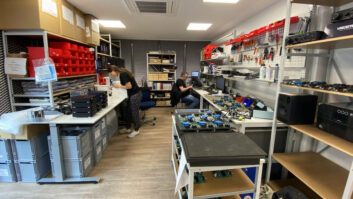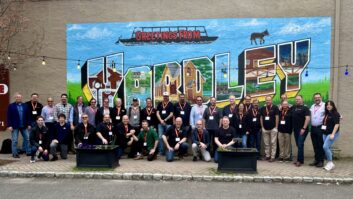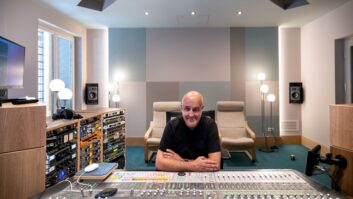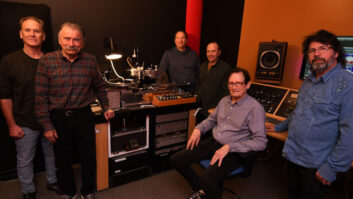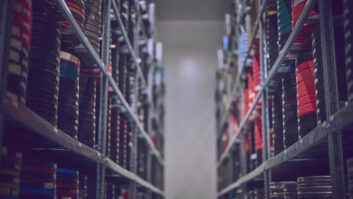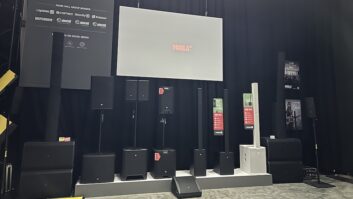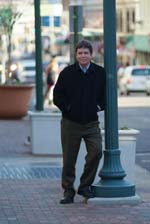
Independent record label Archer Records, based in Memphis, Tenn. and owned by Ward Archer (pictured), has moved its studio and label operations into a 100-year-old limestone building in an historic part of Memphis. Archer’s new facility, Music+Arts Recording and Mixing, now occupies the space that was formerly home to Sounds Unreel recording studio, following Archer Record’s 2007 purchase of Sounds Unreel, which had opened in 1981.
Coinciding with Archer Records’ move into larger facilities, Archer expanded the scope of his business beyond traditional music production to accommodate 5.1 surround mixing for picture, citing a greater need for surround mixes from what he describes as Memphis’ “burgeoning film scene.” To make this possible, Archer revamped and reconfigured Sounds Unreel’s original layout. Music+Arts’ layout was designed by Nashville-based studio designer David Cherry with consultation from George Augsperger.

Music+Arts’ middle-sized iso booth
Music+Arts comprises a control room, a spacious live tracking room and three differently sized iso rooms. “One wall in the cutting [i.e., tracking] room is old brick,” he notes. “It’s uneven brick, and it’s a really nice acoustical surface, I think. Keeps the room from being too dead, yet it’s not reflective. We have a 52-inch Sony monitor above the window. Plus, we have the capability of adding video monitors in other parts within the control room, and also on the cutting-room floor, for people to watch and play.”
Archer works on all projects in his Pro Tools HD3 Accel system, and strongly prefers the sound of analog circuitry: The centerpiece of his control room is a new 48-channel API Vision analog mixing console with an all-discrete signal path that offers stereo and 5.1 mix capabilities (including simultaneous stereo and surround mixing), moving fader automation on 96 faders and up to 108 inputs at mix.

Archer has also built up a solid complement of analog and digital outboard processors that include a TC Electronic System 6000 reverb; Lexicon 224XL, PCM 81 and PCM 91 effects processors; Eventide H3000 SE Harmonizer; Universal Audio 1176 compressors; Urei LA-4 compressor/limiter; custom-built JFL Audio mic preamps; five Vintech X73i mic preamps (“for those who want a Neve sound”); an Avalon Vt-737sp channel strip; and more.
“The whole studio is analog until the very end,” Archer says. “Even the cue system is a Manley 8-channel headphone box [the Langevin Studio Headphone System], and it really sounds terrific. That’s all analog, so there’s no latency issue or anything. The whole studio is wired with Quad wiring, even up to the microphone cables. We have a nice mic collection of Neumanns, Sennheisers and Royers, and we have an RCA 77-DX ribbon that just got back from the shop.”
I spoke with Archer by phone and asked for more of his thoughts about opening Music+Arts.
You say that Memphis’ independent film industry has been expanding in recent years. Could you elaborate on that?
Well, I guess it all began with this guy Craig Brewer, who did Hustle & Flow [as writer and director]. Hustle & Flow won an Oscar [in 2006, in the category of Best Achievement in Music Written for Motion Pictures, Original Song] for “It’s Hard Out Here for a Pimp.” But he was really pushing the indie scene in Memphis a lot, and got that deal with Paramount. And at the same time, Memphis is a great shooting city for major pictures. They shot The Firm here, Castaway, Family Affair, 21 Grams—lots of big pictures. The city’s very friendly, the architecture’s interesting. A film can come to Memphis and pick up a seasoned crew, and that’s what they’re doing. So, there’s a lot of expertise in the city now, and that kind of finds its way into people’s own projects.
So, that’s something that you’re tapping into.
Yeah. There’s really not a place in Memphis to mix to picture—not like what we have. Some people can make it happen, but it’s not ready to go like ours, where you can walk in the door and be at work in short order. We just did our first film mix, a movie called Gospel Hill, starring Danny Glover. And [composer] Scott Bomar is in charge of the music for it, and he recorded a lot of it at his own studio, some of it at ours, and then he mixed it all.
What was Archer Records’ former setup?
I was in downtown Memphis, and I had a smaller studio and a record label. It was more of a place to work on music than it was to actually mix and record, because it was so small. Nonetheless, we did a lot of records in there, and we had a RADAR II machine at that point. So I was looking for a place to move for a couple of years, and then the Sounds Unreel studio came up for sale. I went to take a look at it, and I thought it would be a perfect step up for us. At the time, it was a little bit shop-worn; it had an old Neve 8128 console in it. And after buying it and evaluating it, I decided that it would make more sense to get a new console [rather] than to try to bring [the Neve] up to good condition. Also, it was compounded by the fact that I really wanted to [work] in 5.1, and the [Sounds Unreel] control room wasn’t configured [for that]. So, we wound up redoing the whole thing [laughs].
The record label offices are in half the building, and then the other part is the studio. So it’s possible for somebody to come in and work in the studio on a project unrelated to what we’re doing on the label side, and we can kind of co-exist. We’re probably going to use about half [of the studio space] for artists and then half for music and film. If another label wanted to use [Music+Arts], they wouldn’t have to put the Archer Records name on the credits.

API’s Ross Penniman (left) and studio designer David Cherry
I worked with David Cherry out of Nashville, who is just a wonderful consultant, and a guy in Memphis named Skip McQuinn, who managed the construction of our studios. Actually, Skip approached me about the studio in the first place, but then he referred me to David Cherry, who is a designer and one of the greatest wiring people I’ve ever run across. I mean, you keep thinking his expertise is going to end at some point, but it just keeps on going! And he has a wonderful grasp of not only audio, but also video and how to make it work together. We have mix-for-picture capability, which is pretty sophisticated, and he put [that] together for us. We asked George Augsperger to review the design. He made suggestions, and we began to build it.
How did you decide to purchase an API Vision console?
There’s not an API console in Memphis, but everybody loves API. Almost every studio has API preamps. I just happened to call API. I knew about the Vision console, but I didn’t know that much about it. But I found out that there was a sale that had fallen through on one, and they offered me an offer I couldn’t refuse. It’s the perfect console for the room, and it sounds great. The automation is easy and it appears to be stable. This is really not a multimillion-dollar facility, where you can afford to have full-time techs. It’s got the same circuitry that the other [API consoles] do—lots of transformers, no microprocessors in the audio path—and the most comprehensive patchbay I think I’ve ever seen. It’s 13 patch points per channel. It’s not attached to the console; it’s separate. All the outboard gear is routed to it, as is the console and all recording gear.
We’ve got a pretty robust Pro Tools system, and we can handle up to 96 tracks played back. We have five 192s, and then we have wiring for a sixth, but we have to use it as a spare. But on this console, you can automate both the lower and the upper sets of faders. You can really mix a lot of stuff on it. The way we’re set up now, if you walked in the door, you could run 80 tracks through it very easily and mix them, and use the upper and lower faders. And then the last 16 upper faders are used for various reverb returns that also can be automated. We also have a Sony APR24 24-track and an Ampex ATR 2-track—it’s half-inch—just for kicks. To sync the picture together, the Pro Tools system is locked to blackburst for total frame accuracy. We put the video files into DV files that go into Pro Tools, and then it can be synched up.
For your 5.1 surround system, you chose PMC’s IB2S-A monitors and XB2 subwoofer, which you also use with Yamaha NS-10s, as an alternative.
I had heard from others how good the [PMC] speakers were. The ones that we have are the perfect size. The room doesn’t have soffit-mounted speakers; they’re mounted on stands, and this is the perfect speaker for it. They’re really terrific-sounding speakers—terrific low end. I mean, we’ve run test tones on them and they get down to 20-something cycles, and those speakers are popping back and forth, but they’re crazy—they handle it. I’m pretty impressed with them. [PMC’s] Maurice Patist came down and sort of helped us install them, and tuned the room, so to speak. Those speakers are a full-range 5.1 system; it’s not a satellite deal. And hearing full-range 5.1 is a big difference to me, particularly also in mixing music; it’s a whole different experience.
For more information on Music+Arts and Archer Records, visit www.myspace.com/music_arts, www.myspace.com/archerrecords and www.archer-records.com.
